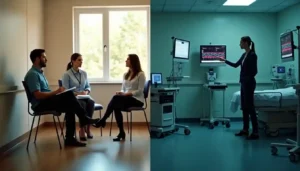
Brachial plexus birth injury affects 1 to 3 out of every 1,000 newborns, making it one of the most common birth-related injuries in the United States. The rate has dropped from 1.5 to 0.9 per 1,000 live births in the last two decades, yet this condition continues to affect families deeply. This complex nerve injury involves a network of about 350,000 individual nerve fibers and can happen during difficult deliveries, especially when you have shoulder dystocia.
Parents often feel overwhelmed when they learn about their child’s brachial plexus injury at birth. Keep in mind that most infants regain movement and feeling in their affected arm with proper treatment. The condition persists into adulthood for about one-third of babies, but many treatment options are available – from physical therapy to specialized surgical procedures. This piece will help you understand diagnosis, treatment options, recovery timelines, and support systems for families who face this challenge.
Understanding the First Signs of Brachial Plexus Injury at Birth
A newborn’s trauma to the nerve network in the neck and shoulder area shows physical signs shortly after birth. Early detection of these indicators allows quick intervention that can substantially affect long-term outcomes.
Common delivery scenarios leading to nerve damage
The brachial plexus can sustain injury in several birth circumstances. Babies face the highest risk from shoulder dystocia—a condition where the baby’s shoulder gets stuck behind the mother’s pelvis during delivery.
Other risk factors include:
- Large gestational size: Babies weighing more than 8-9 pounds face increased risk
- Breech presentation: Feet-first deliveries put pressure on the baby’s raised arms
- Prolonged or difficult labor: Extended pushing phases strain nerve networks
- Instrument-assisted births: Vacuum or forceps extractions increase injury likelihood
- Maternal diabetes: This condition relates to higher rates of brachial plexus injuries
- Multiple births: Twins or triplets face greater complications
- Previous history: Prior deliveries with shoulder dystocia raise the risk substantially
Brachial plexus birth injuries occur in 1 to 3 out of every 1,000 live births. These numbers make them common among birth-related complications.
Early symptoms: Moro reflex absence and arm immobility
Healthcare providers can spot the clearest signs of brachial plexus injury within 24 hours after birth. Medical teams carefully assess several key indicators.
The affected side’s absent or asymmetrical Moro reflex (startle response) serves as a primary indicator. Healthy babies throw back their head, extend their arms and legs, then pull them back during this reflex test. Babies with brachial plexus damage show partial or complete absence of this response.
Physical examination typically reveals:
- No movement in the upper or lower arm and hand on the affected side
- Arm held straight at the elbow and against the body (known as “Erb posture“)
- Decreased grip strength on the affected side
- Asymmetrical arm movement when the baby rolls side to side
Parents and medical providers often notice asymmetrical arm movements during crying or routine handling first. Clinical examination determines whether the injury affects the upper plexus (Erb’s palsy) or lower plexus (Klumpke’s palsy).
Month-by-Month Recovery Timeline for Parents
Weeks 1–4: Original diagnosis and physical therapy startTracking your child’s recovery after a brachial plexus birth injury requires understanding milestone patterns at specific times. Recovery follows a predictable path that helps parents anticipate their child’s healing experience.
A detailed evaluation by a pediatric orthopedist or brachial plexus specialist can safely wait up to four weeks. Healthcare providers perform physical examinations to assess nerve damage severity and create a baseline for progress monitoring. Your baby can start gentle range-of-motion exercises around 3 weeks of age during this significant period.
Physical therapists teach parents daily exercises to maintain joint flexibility and prevent contractures—a condition that makes joints permanently stiff. These first weeks reveal whether nerves have just been stretched or suffered more serious damage.

Months 2–3: Monitoring grip strength and shoulder movement
Recovery patterns become clear by the second month. Babies who regain complete elbow flexion by 2 months usually achieve full arm function recovery within their first 2 years. Research shows that gripforce in the affected hand of children with upper brachial plexus palsy measures 23% lower than healthy controls.
Your baby might need reconstruction surgery if no recovery signs appear by month 3. This timing matters because all but one of these infants with brachial plexus birth injury show complete spontaneous recovery by 2 months.
Months 4–6: Deciding on imaging and specialist referrals
Healthcare providers often order imaging tests like MRI, CT myelography, or electromyography (EMG) between months 4-6 to check nerve conditions thoroughly.
Strength improvements at this stage determine if surgery becomes necessary. The best window for surgical intervention falls between 3-6 months after injury. Waiting longer might reduce successful outcomes.
Months 7–12: Evaluating for surgery or continued therapy
The greatest recovery potential exists in the first year. The “cookie test” at 9 months helps doctors identify surgical candidates. Strength, range of motion, and control improvements continue up to 18 months after surgery.
Your child needs ongoing exercises and splinting therapy to prevent stiffness and strengthen the arm over time, whatever treatment path you choose.
Treatment Options: From Home Exercises to Surgery
Your child’s treatment for brachial plexus birth injury starts with basic care and moves to surgery if needed. A team of specialists will work together to give your child detailed care. This team includes neurologists, neurosurgeons, physical therapists, and occupational therapists.
Daily range-of-motion therapy and teapot splinting
Physical therapy is the life-blood of brachial plexus injury treatment. These exercises keep joints flexible and stop permanent joint stiffness from developing without proper movement. Parents become the main therapists. They need to do range-of-motion exercises many times each day, best done during diaper changes.
The exercises should be:
- Done slowly and gently on a firm surface
- Held for 10 seconds at the end range
- Repeated 5 times per session
- Done at least 3 times daily
The “teapot splint” is a vital nighttime tool for babies who develop shoulder tightness. Parents should put this special brace on while their baby sleeps. Thin pajamas work best to prevent bunching, and a boot sock keeps the arm warm.
When nerve grafts or transfers are needed
Most children recover without surgery. Nerve reconstruction becomes necessary if we don’t see much improvement by 3-6 months of age. Surgical options include:
Nerve grafting removes damaged nerve sections and replaces them with nerve grafts, usually taken from the leg (sural nerves). Nerve transfers can redirect working nerves from the arm or chest to take over for damaged nerves.
Nerve surgery works best between 3-9 months after birth. This helps children under one year the most, as nerve repair is nowhere near as effective after this time.

Post-surgical recovery: What to expect in 6–18 months
Nerves heal very slowly after reconstruction, so patience matters. Your child might show small movements after a few weeks, but real improvements take months. Elbow function often improves 6-12 months after surgery, with shoulder improvements coming at 12-18 months.
Physical therapy stays important during recovery. Your child may need splinting for 2-4 weeks after nerve transfers below the elbow. More complex procedures need support for 1-3 months. Some children might still have weakness in their shoulder, arm, hand, or fingers and may need more procedures as they grow.
Legal and Emotional Support for Families
Families dealing with a brachial plexus birth injury face medical challenges alongside legal and emotional hurdles. The right resources can make a real difference in your family’s path to healing.
Getting Help From a Brachial Plexus Birth Injury Lawyer
Medical negligence might have caused your child’s brachial plexus injury. You should talk to an experienced birth injury attorney right away. States have specific time limits to file claims. A lawyer who knows brachial plexus injuries can help you:
- Break down delivery details and medical records
- Work with medical experts to prove negligence
- Direct you through legal procedures
- Get compensation for treatment costs
Research shows that specialized treatment for brachial plexus birth palsy throughout life can cost up to $1 million. Legal action helps secure money needed for your child’s care. Most attorneys provide free consultations and only get paid after winning compensation.
Support Groups and Mental Health Resources for Parents
Taking care of a child with a brachial plexus injury takes an emotional toll. Studies reveal that 42% of mothers with newborns affected by brachial plexus injuries show PTSD symptoms [link_2]. Depression symptoms appear in 15% of cases – much higher than mothers with healthy newborns.
These organizations provide support:
- United Brachial Plexus Network (UBPN): This nonprofit gives educational resources, disability benefit information, awareness programs, and runs a private Facebook group with over 5,000 members.
- Midwest Brachial Plexus Network (MBPN): Provides support, resources, and hosts a free annual summer camp for families to connect.
- Cameron’s Smile BPI Support: Holds regular support meetings and yearly events.
Healthcare providers should include mental health screening and treatment in brachial plexus clinics. Young people with these injuries say discussing mental health during clinic visits would help them.

Conclusion
Brachial plexus birth injuries touch the lives of thousands of families each year. Medical advances and early intervention strategies give hope to affected children. Most babies show substantial recovery within their first year when they receive proper diagnosis and timely treatment.
Parents should focus on these key points:
- Physical signs and Moro reflex testing help detect the condition early and lead to quick intervention
- Recovery follows a predictable path, with vital developments happening in the first 3-6 months
- Treatment ranges from daily exercises to specialized surgical procedures
- Physical therapy plays a key role throughout recovery
- Emotional and legal support networks are ready to help families
Medical research brings better treatment methods for brachial plexus injuries. Support organizations provide great resources to affected families. Dedicated healthcare teams, combined with proper therapy and support, help many children reach their full potential despite the challenges.
The path ahead may look overwhelming, but you have support. Healthcare providers, support groups, and specialized treatment centers collaborate to create the best possible future for children with brachial plexus injuries. Your child’s recovery depends on understanding your options and getting help early.

FAQs
Q1. What are the early signs of a brachial plexus birth injury? Early signs include an absent or asymmetrical Moro reflex, lack of movement in the affected arm, decreased grip strength, and the arm being held straight at the elbow against the body. These symptoms typically appear within the first 24 hours after birth.
Q2. How long does recovery from a brachial plexus birth injury usually take? Recovery timelines vary, but most significant improvements occur within the first year. Many infants show complete recovery by 2 months, while others may require ongoing therapy or surgery. Improvements can continue for up to 18 months post-treatment.
Q3. What treatment options are available for brachial plexus birth injuries? Treatment options range from conservative approaches like daily range-of-motion exercises and splinting to surgical interventions such as nerve grafts or transfers. The choice depends on the severity of the injury and the child’s progress during the first few months.
Q4. When should parents consider legal action for a brachial plexus birth injury? Parents should consider consulting a specialized birth injury lawyer if they suspect medical negligence led to their child’s injury. It’s important to act promptly due to statutes of limitations, and many attorneys offer free consultations and work on contingency fees.
Q5. Are there support groups available for families dealing with brachial plexus birth injuries? Yes, several organizations offer support, including the United Brachial Plexus Network (UBPN), Midwest Brachial Plexus Network (MBPN), and Cameron’s Smile BPI Support. These groups provide resources, connect families, and sometimes host events to support affected individuals and their families.
Call Brachial Plexus Birth Injury Lawyer Timothy L. Miles Today for a Free Case Evaluation
If you your child suffered a brachial plexus birth injury, call Brachial plexus birth injury lawyer Timothy L. Miles for a free case evaluation day. (855) 846-6529.
And, no matter how bad the circumstances may seem, may you find comfort and remember one thing:
Justice is, and will always be, blind to the love of profit.



